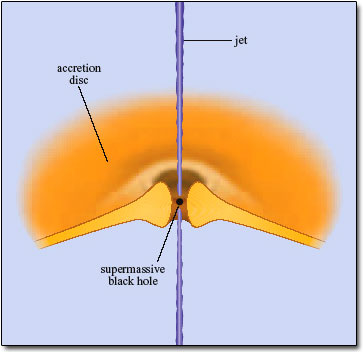4.7 Jets
You have seen that two kinds of active galaxies - quasars and radio galaxies - are often seen to possess narrow features called jets projecting up to several hundred kiloparsecs from their nuclei. If these are indeed streams of energetic particles flowing from the central engine, how do they fit with the accretion disc model? How could the jets be produced?
The answers to these questions are not fully resolved, but there are some aspects of the model of the central engine which probably play an important part in jet formation. A key idea is that the jets are probably aligned with the axis of rotation of the disc - since this is the only natural straight-line direction that is defined by the system. This much is accepted by most astrophysicists, but the question of how material that is initially spiralling in comes to be ejected along the rotation axis of the disc at relativistic speeds (i.e. speeds that are very close to the speed of light) is an unsolved problem.
One mechanism that has been suggested requires that at distances very close to the black hole the accretion disc becomes thickened and forms a pair of opposed funnels aligned with the rotation axis, as illustrated in Figure 31. Within these funnels the intense radiation pressure causes the acceleration and ejection of matter along the rotation axis of the disc. Unfortunately, this model fails in that it cannot produce beams of ejected particles that are energetic enough to explain the observed properties of real jets. Other variants of this scenario, and in particular those in which the magnetic field of the disc plays a major role in the ejection of jets are under investigation but do not yet offer a full explanation of the jet phenomenon.

If jets are ejected along the rotation axis of the disc, then why do quasars and the more powerful radio galaxies generally only appear to have a single jet? It seems improbable that the engine produces a jet on one side only, and it is thought that there are indeed two jets but only one is visible. In this model, two jets are emitted at highly relativistic speeds, and one of them is pointing in our direction and the other is pointing away. Due to an effect called relativistic beaming, the radiation from the jets is concentrated in the forward direction. The jet consequence of this is that if a jet is pointing even only very approximately towards us it will appear very much brighter than would a similar jet that is pointing in the opposite direction. (The special case of what happens when a jet is pointing directly at us will be considered in the next section.)
Question 10
Estimate the accretion rate on to a black hole needed to account for the luminosity of a Seyfert nucleus that has twice the luminosity of our Galaxy. Express your answer in solar masses per year. What, other than the mass accretion rate, limits the luminosity?
Answer
For the Seyfert nucleus, L = 4 × 1010L⊙ = 1.6 × 1037 W. By Equation 3.5, Q = L(0.1c2). Substituting for L,

This can be converted into solar masses per year, by using 1 year ≈ 3 × 107 s, and M⊙ ≈ 2 × 1030 kg, giving

The Eddington limit places an upper limit on the luminosity for a black hole of given mass.
